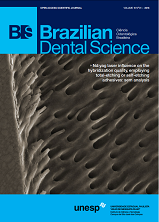Influence of drying time of adhesive systems on the bond strength between resin cement and feldspathic ceramic
DOI:
https://doi.org/10.14295/bds.2016.v19i1.1194Abstract
Objective: This study evaluated the effect of drying times of two total-etch & rinse adhesives on the resin bond strength to a feldsphatic ceramic, before and after aging. Material and Methods: Feldsphatic-ceramic CAD-CAM bars were cut into blocks (12×10×4 mm) with a cutting machine (N = 32). Impressions were made of each ceramic block with silicone putty material and the negative space was filled with a composite resin. The bonding ceramic surface was etched with hydrofluoric acid, silanized, and the adhesive system (SB- Single Bond 2, 3M-ESPE; or PB- Prime & Bond NT, Dentsply) was applied. The samples were dried at different times (5, 10 and 15 s) before the cementation. The resin and ceramic blocks were cemented by a dual cure resin cement. All samples were stored in distilled water at 37 °C for 24 h. For the ?-TBS test, the samples were sliced into microbars. Half of the bars of each block was tested after 24 h and, the other bars were submitted to thermocycling (12,000×) and water storage (150 d). For the 24 h groups, the longer drying time increased (p < 0.05) the bond strength of SB (water/alcohol adhesive), while reduced (p < 0.05) for the PB group (acetone based adhesive). Results: For the aged groups, the bond strength for the different drying times had no significant difference, for the both adhesives. Conclusion: Longer drying times increased the bond strength values of SB. Smaller drying times increased the bond strength values of PB. The aging protocol influenced the bond strength of SB groups.
Keywords: Microtensile; Adhesion; Feldspar ceramic; Drying time; Adhesive system.
Downloads
Downloads
Published
How to Cite
Issue
Section
License
Brazilian Dental Science uses the Creative Commons (CC-BY 4.0) license, thus preserving the integrity of articles in an open access environment. The journal allows the author to retain publishing rights without restrictions.
=================




























